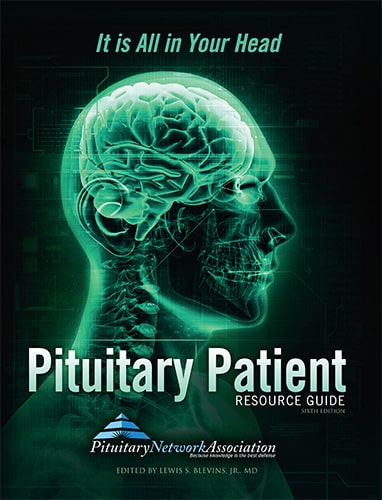News Articles February 2022
Written on 04 February 2022.
Why Are Mental Health Symptoms Connected With Pituitary Disorders?
This is a complex and not completely understood area of pituitary medicine. Of course it is very logical and reasonable for anyone who has physical limitations, pain, discomfort to feel sad about a loss or change in their body functioning. Depression, which is different than sadness, is cited as a component of many chronic and/or serious physical illnesses. But pituitary disorders have a unique relationship with mental and emotional states. The chemistry of how such hormones as Prolactin and Cortisol act upon the brain is thought to either directly or indirectly causes psychological problems. There is also evidence linking emotional trauma, especially early in life, to later development of pituitary/Neuroendocrine disorders. Emotional factors are also known to affect the immune system. Thyroid hormones are also known to affect brain function and behavior and sensitive to environmental factors that cause stress. Therefore, a combination of stressful life events combined with a persons unique vulnerabilities and the powerful forces of certain hormones seem to commonly bring pituitary tumors and other Neuroendocrine disorders together with mental and emotional disturbances.
What Happens After A Tumor Is Removed/Treated?
There may be permanent loss of some or all pituitary hormones, an imbalance that can be treated with Hormone Replacement Therapy, which has been inaccurately associated with only one group of patients: post-menopausal women. HRT can replace thyroid, growth, testosterone, or adrenal hormones when those made by the pituitary to stimulate the endocrine glands are no longer produced. It can be lifesaving therapy for the many millions of patients who need to replace hormones they no longer make.
What Is A Pituitary Tumor?
A pituitary tumor is an abnormal growth of pituitary cells. Pituitary tumors can either be nonfunctional (that is they do not secrete hormones) or produce specific hormones, such as prolactin (causing infertility, decreased libido, and osteoporosis), growth hormone (causing acromegaly), ACTH (causing Cushing’s), TSH (causing hypothyroidism), or be nonfunctional (that is they do not produce hormones). These tumors behave according to their cell of origin and are named for the specific cell type affected. For example, if a tumor originates in a prolactin producing cell, the patient develops a prolactinoma-a prolactin secreting pituitary tumor that is common and usually treatable. High prolactin levels suppress production of the pituitary hormones (luteinizing hormone and follicle stimulating hormone) that stimulate production of estrogen or testosterone. Men with these tumors have low testosterone levels and lose their sex drive and eventually their masculine characteristics-hair, muscle, erections, and ability to produce sperm. Women with prolactin producing tumors often do not ovulate, experience low estrogen levels, and cease having menstrual periods. In both cases, patients with low sex hormones develop osteoporosis. It is important to remember that most pituitary tumors are benign and cancer is very rare. They have variable patterns of growth and affect different people in vastly different ways. Some are small and incidental, while others are small but cause hormone excess. Others may be rapidly growing mass lesions.
What Causes The Pituitary To Malfunction?
Tumors (overwhelmingly benign), inflammation, infections and injury can cause the gland to malfunction, as well as metastasis or spread of other tumors to the pituitary (rare). Radiation therapy to the brain can also cause normal pituitary cells to malfunction.
What Happens If The Pituitary Produces Either Too Much Or Too Little Of These Hormones?
An imbalance occurs, leading to more than a dozen disorders of the endocrine system. Deficiency of thyroid hormone, adrenal cortical hormone (cortisol) or antidiuretic hormone (vasopressin) is rapidly life-threatening. In patients with abnormalities of the other hormones, quality of life is significantly compromised.
Is “The Master Gland” Connected To The Brain?
The pituitary hangs from the hypothalamus, a part of the brain located immediately above it, by a thread-like stalk that contains both blood vessels and nerves. Hormones produced in the hypothalamus carry signals or messages to the pituitary gland. The hypothalamus serves as a “switching station” to relay signals from many different parts of the brain to the pituitary gland, which in turn transmits its own signals to various parts of the body. The pituitary is divided into a larger anterior region (adenohypophysis) and a smaller posterior area (neurohypophysis). It sits in a small pocket of bone in the base of the skull called the pituitary fossa, also known as the sella turcica, or Turkish saddle, because of the resemblance. The sella turcica is located deep within the skull, which can be imagined by drawing an imaginary line from the top of the nose through the brain to the back of the head, and from ear to ear. The point at which they intersect is where the pituitary gland sits.
How Effective Is Radiation Therapy?
Radiation therapy uses high-energy x-rays to kill cancer cells and abnormal pituitary cells and shrink tumors. Radiation for pituitary tumors these days almost always comes from a radiation source outside the body (external radiation therapy). Radiation therapy may be used if medication/surgery fails to control the tumor. There are several different types of radiation therapy.
- Standard External Beam Radiotherapy uses a radiation source that is nonselective and radiates all cells in the path of the beam; in almost all cases other portions of the brain in the area of the pituitary are in the path of the radiation beam.
- Proton Beam Treatment employs a specific type of radiation in which “protons”, a form of radioactivity, are directed specifically to the pituitary gland. The advantage of this technique is less damage to tissues surrounding the pituitary gland.
- Gamma Knife Irradiation combines standard external beam radiotherapy with a technique that focuses the radiation through many different ports. This treatment tends to do less damage to tissues adjacent to the pituitary gland. Some clinics are using proton beam therapy; laser-guided MR imaged stereotactic intrasellar tumor localization can be used for selected patients with untreated pituitary tumors, incomplete surgical resection, or tumor recurrence.
Are Pituitary Disorders/Diseases Hereditary?
Rarely pituitary adenomas can occur in families. If no other abnormality is associated then this condition is called Familial Isolated Pituitary Adenoma. Most often family members have acromegaly or prolactinoma, sometimes other types of adenomas. Further information is available on www.fipapatients.org.
What Are The Symptoms Of A Pituitary Or Other Neuroendocrine Disorder? (LINKS)
|
|
|
|
|
|
|
|
|
|
|
|
|
|
|
|
|
|
|
|
|
If a tumor forms in an ACTH secreting pituitary cell, it could result in the overproduction of cortisol (Cushing’s Disease) or the underproduction of cortisol (adrenal insufficiency, often referred to as Secondary Addison’s Disease). Cushing’s is a condition characterized by excessive fat accumulation in central parts of the body (obesity, including a rounded or fat-filled face), diabetes, hypertension, a low serum potassium, thinning and bruising of skin, and osteoporosis.
Symptoms of adrenal insufficiency include dehydration, low blood pressure and sodium level, and excessive weight loss. Primary Addison’s Disease is caused when the adrenal glands fail to respond to directions from the pituitary and hypothalamus.
If the tumor forms in a growth hormone producing cell, it can overproduce growth hormone. Tumors that form from growth hormone producing cells cause two different clinical pictures. If they occur in children before the growth plates in long bones have closed, excessive growth hormone will cause gigantism. If the growth hormone excess occurs during adulthood there is excessive enlargement of the hands, feet, and jaw, as well as soft tissue swelling of many tissues (acromegaly). Acromegaly is associated with an increased probability of developing diabetes mellitus, heart attack, hypertension, and certain types of cancer including malignancy of the colon. Most commonly the facial changes develop subtly and may not be noticed by the patient or his/her family.
To read more about symptoms and other Pituitary Disorders, visit our Disorders section.
For more on the pituitary and prevelence of disorders, visit our One in Five section.
For more on the pituitary and how it works, visit Pituitary Basics.
Are Pituitary Tumors Deadly?
If diagnosed early enough, the prognosis is typically excellent. If not, some tumors can grow into macroadenomas that press on the optic nerves (causing loss of peripheral vision and, in some cases, blindness), the brain (impacting function) and the pituitary (limiting or eliminating hormone production). Large tumors can also invade the cavernous sinuses, which house the carotid arteries, the veins to drain the eyes, and nerves involved in eye movement. Surgery around the cavernous sinuses is difficult and should be performed by an experienced pituitary surgeon. The tumors can also secrete too much of a hormone, causing hypertension, diabetes, mood disorders, sexual dysfunction, infertility, osteoporosis, arthritis, accelerated heart disease and death.
Available Now!

The Pituitary Patient Resource Guide Sixth Edition is now available! Be one of the first to have the most up-to-date information. The Pituitary Patient Resource Guide a one of a kind publication intended as an invaluable source of information not only for patients but also their families, physicians, and all health care providers. It contains information on symptoms, proper testing, how to get a diagnosis, and the treatment options that are available. It also includes Pituitary Network Association's patient resource listings for expert medical care.





